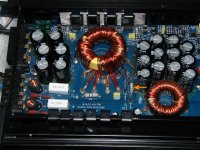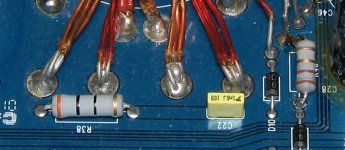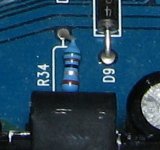I recently got an Arc Audio 1500DR with the TA0102A tripath chip in it, The previous owner said the chip was burned out.
How do i go about testing these types of chips?
Thanks
How do i go about testing these types of chips?
Thanks
The green LED will blink rapidly , From what ive read they throw error codes when they fault, I cannot find a list though.
No excessive current or dc on terminals.
No excessive current or dc on terminals.
I have all of the data sheets for the Tripath chips, TA102A, TA103A, TA104A, and TA105A if that might help you, it is difficult to find the data sheets for these anymore. It has been a while, but I don't recall anything about the modules coding errors, but I do know that they can crap the bed at the drop of a hat and there is pretty much no replacements out there anymore.
LMK if you want the data sheets.
Later,
Jason
LMK if you want the data sheets.
Later,
Jason
Rabbi:
I looked up the owner's manual for the Clarion equivalent and it didn't mention any codes. I couldn't find a manual for the arc.
It's possible that the 1.1 ohm resistor in this amp (photo) isn't the original but I think the resistor is supposed to be 1 or 1.1 ohms. In the photo, you can see that the colors are pretty accurate and the resistor at the left with the orange band is clearly different than the brown bands. At 3.3, it's unlikely to cause a problem but you may want to replace it.
jcampb2:
I think you could probably repair the modules. Many of the components inside the module are ordinary SMD transistors and resistors. You'd need clear photos of the inside of a working module to determine the values of the burned components.
I looked up the owner's manual for the Clarion equivalent and it didn't mention any codes. I couldn't find a manual for the arc.
It's possible that the 1.1 ohm resistor in this amp (photo) isn't the original but I think the resistor is supposed to be 1 or 1.1 ohms. In the photo, you can see that the colors are pretty accurate and the resistor at the left with the orange band is clearly different than the brown bands. At 3.3, it's unlikely to cause a problem but you may want to replace it.
jcampb2:
I think you could probably repair the modules. Many of the components inside the module are ordinary SMD transistors and resistors. You'd need clear photos of the inside of a working module to determine the values of the burned components.
Attachments
No, especially if the solder connections on it look original. I'm not 100% sure that the one in the arc amp was the original but I've had at least one other person with a 1.1 ohm in their amp. If I'm not mistaken, this supplies 12v to pin 19 on the Tripath module. If you have 12v there, this isn't an issue.
The Tripath modules have no codes to read. Any flashing power indicators are something the amp company added to indicate trouble nothing more.
Tripath modules lack any Microprocessor power inside to do such things.
Also the more common failure points of many Tripath modules is the twin internal gate driver circuitry and its embedded chip design where the silicon is covered by black sealant I have never seen anyone be able to repair these so far. The main encoding chip is a off the shelf Tripath SMD device. Other then that there are current limiting SMD resistors and what not located under the black lid that do burn out also, but don't be surprised if these are symptoms/indicators of other failure related issues.
None of the Tripath modules are really interchangeable so swapping up or down the product chain is not a advisable thing to do. It seems there was something special about each chips protection circuitry that prevents them from operating reliably say if you jump form a 02a to a 03A modules or a 04A module, something about scaling of the power supply rails.
I have a working Clarion 800 watt amp here I keep, and it had a bad 2 watt ceramic power resistor on the 12 volt supply to the Tripath chip. Once it was replaced and resoldered with silver solder the amp came back to life. Something to do with way too much voltage drop and heat build up, but it was not a module failure. It was a Clarion build/design issue, as it's located outside of the module on the board. This is the one Perry is talking about and it is easily found on the Clarion schematic.
These modules can go silent if any internal current limit opens up, or the encoding chip fails, or the Mosfet gate drivers fail. but the later usually caused the outputs to fail also.
PG made one of these creatures called them the Tantrum 1200.1, I also own two of these, but do not use them because if the modules go inside them I know I will not find any replacements anywhere of a exact module model.
Even Clarion does no service their 800 watt version of this amp any longer due to no supply of Tripath chips and this was told to me 4 years ago by Clarion when i tried to order a replacement module.
Tripath was a local Silicon Valley company and I lived near them while they were in business. They filed chapter 11 then 13 and were eventually bought out by another company as I recall. There are no stocks of part except those that have been hoarded by folks along the way. The 04A chip is available on that auction site form a fella that used to work for PG before the sell off to AAMP, I think he wants about ~$30.00 for the 04A module that was used in many home amps setups and the Audiosource Tripath home amp....
Make sure the Tripath chip has all of its supply rails or it will be muted especially the 12 volt supply that uses a high V drop regulator usually attached to the sink near the front end of any of these designs. it actually feeds the Tripath chip and must be functional or it will be silent.
Your flashing LED is caused by the Tripath chips protection output triggering the main supply to shutdown, The amp maker made it flash ...not Tripath.....Best of luck 🙂
Tripath modules lack any Microprocessor power inside to do such things.
Also the more common failure points of many Tripath modules is the twin internal gate driver circuitry and its embedded chip design where the silicon is covered by black sealant I have never seen anyone be able to repair these so far. The main encoding chip is a off the shelf Tripath SMD device. Other then that there are current limiting SMD resistors and what not located under the black lid that do burn out also, but don't be surprised if these are symptoms/indicators of other failure related issues.
None of the Tripath modules are really interchangeable so swapping up or down the product chain is not a advisable thing to do. It seems there was something special about each chips protection circuitry that prevents them from operating reliably say if you jump form a 02a to a 03A modules or a 04A module, something about scaling of the power supply rails.
I have a working Clarion 800 watt amp here I keep, and it had a bad 2 watt ceramic power resistor on the 12 volt supply to the Tripath chip. Once it was replaced and resoldered with silver solder the amp came back to life. Something to do with way too much voltage drop and heat build up, but it was not a module failure. It was a Clarion build/design issue, as it's located outside of the module on the board. This is the one Perry is talking about and it is easily found on the Clarion schematic.
These modules can go silent if any internal current limit opens up, or the encoding chip fails, or the Mosfet gate drivers fail. but the later usually caused the outputs to fail also.
PG made one of these creatures called them the Tantrum 1200.1, I also own two of these, but do not use them because if the modules go inside them I know I will not find any replacements anywhere of a exact module model.
Even Clarion does no service their 800 watt version of this amp any longer due to no supply of Tripath chips and this was told to me 4 years ago by Clarion when i tried to order a replacement module.
Tripath was a local Silicon Valley company and I lived near them while they were in business. They filed chapter 11 then 13 and were eventually bought out by another company as I recall. There are no stocks of part except those that have been hoarded by folks along the way. The 04A chip is available on that auction site form a fella that used to work for PG before the sell off to AAMP, I think he wants about ~$30.00 for the 04A module that was used in many home amps setups and the Audiosource Tripath home amp....
Make sure the Tripath chip has all of its supply rails or it will be muted especially the 12 volt supply that uses a high V drop regulator usually attached to the sink near the front end of any of these designs. it actually feeds the Tripath chip and must be functional or it will be silent.
Your flashing LED is caused by the Tripath chips protection output triggering the main supply to shutdown, The amp maker made it flash ...not Tripath.....Best of luck 🙂
I've seen the insides of several of the ICs and none were potted. Breaking the cover around the perimeter exposed the components. I had photos of the insides of one of them but somehow lost them.
I Somehow missed a burned up resistor
R34 is the location
I can only see the first ring is green and the last ring is gold, Its a 1/4watt
It reads 3.8ohms
R34 is the location
I can only see the first ring is green and the last ring is gold, Its a 1/4watt
It reads 3.8ohms
Its the red circle
An externally hosted image should be here but it was not working when we last tested it.
The Tripath TA010x modules are nothing but a headache. They are not worth replacing IMHO.
They have a design flaw where the gate drivers blow if the output FETs short for any reason. All of the modules I've disected had the gate drivers potted in epoxy.
If you are experienced enough, you could build your own replacement out of a TC2000/TC2001 and a set of suitable gate drivers. This has been done commercially with the RA2500 sold by Profusion PLC.
There is a way to check if the module is blown by measuring the resistance of a couple of the pins. I will have to dig mine up to check which ones.
They have a design flaw where the gate drivers blow if the output FETs short for any reason. All of the modules I've disected had the gate drivers potted in epoxy.
If you are experienced enough, you could build your own replacement out of a TC2000/TC2001 and a set of suitable gate drivers. This has been done commercially with the RA2500 sold by Profusion PLC.
There is a way to check if the module is blown by measuring the resistance of a couple of the pins. I will have to dig mine up to check which ones.
I've seen the insides of several of the ICs and none were potted. Breaking the cover around the perimeter exposed the components. I had photos of the insides of one of them but somehow lost them.
I have one ( >4Mb file size) showing two side by side. I forgot where I got it. probably here (one of TheAnonymous1's threads?) I can email it if you like...
I think 41hz is also making a replacement board for the big T amp chips but I don't have idea if or when they will release it.
I replaced R31 with the proper resistor and tried to idle the amp.
The amp appeared to idle fine for a few moments until it blew this capacitor
I Also noticed the tripath chip got warm within this short timeframe.
The amp appeared to idle fine for a few moments until it blew this capacitor
An externally hosted image should be here but it was not working when we last tested it.
I Also noticed the tripath chip got warm within this short timeframe.
Last edited:
The module is toast, I'd give up before you waste too much time and money. Even if you got it all fixed, there is a very high chance it will die again eventually.
Have you checked to see if the output FETs are shorted? If they are, the module is a guaranteed goner as well.
Here is something to keep in mind when messing with a TA010x amp.....
Good module + dead FETs = Dead module
Dead module + good FETs = Dead FETs
Good module + good FETs = One of the above eventually
Have you checked to see if the output FETs are shorted? If they are, the module is a guaranteed goner as well.
Here is something to keep in mind when messing with a TA010x amp.....
Good module + dead FETs = Dead module
Dead module + good FETs = Dead FETs
Good module + good FETs = One of the above eventually
- Status
- Not open for further replies.
- Home
- General Interest
- Car Audio
- Testing Tripath TA0102A ?


